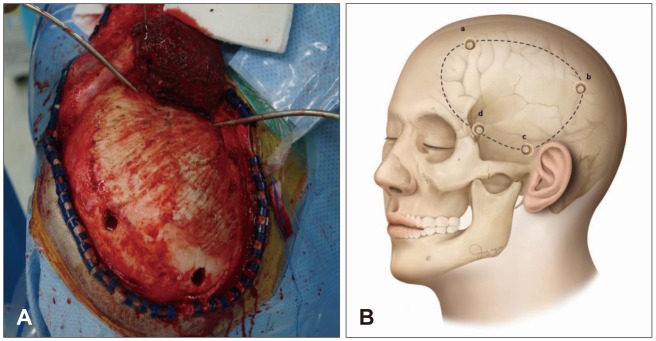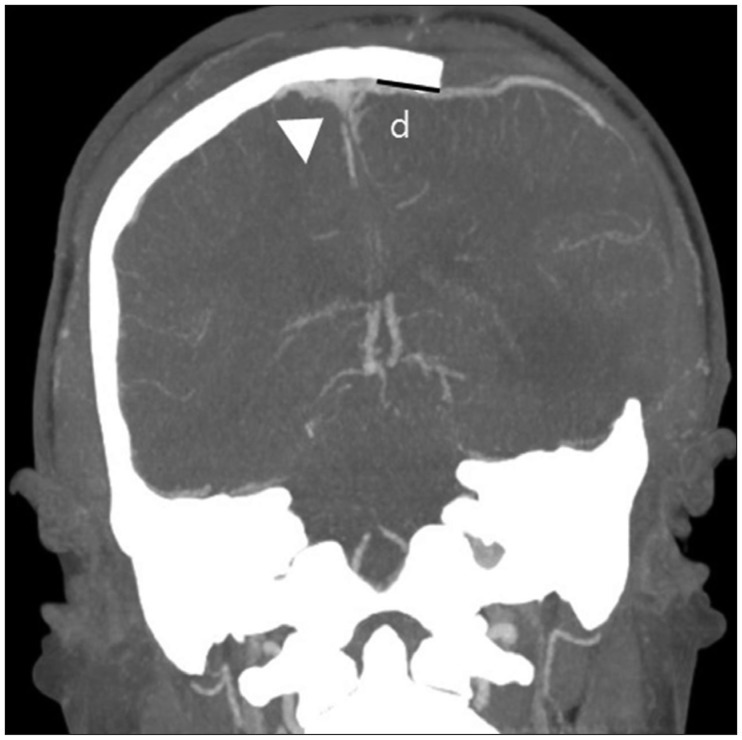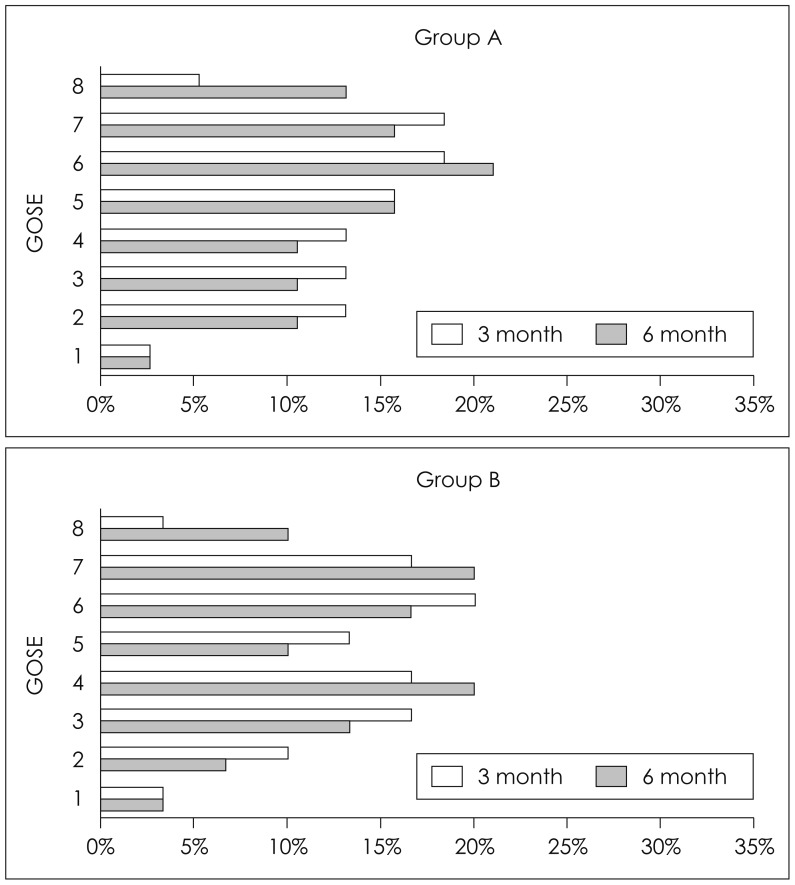1. Adewumi D, Colohan A. Decompressive craniectomy: Surgical indications, clinical considerations and rationale. In : Agrawal A, editor. Brain injury: Pathogenesis, monitoring, recovery and management. Rijeka, HR: InTech;2012. p. 475–486.
2. Bernard AC, Davenport DL, Chang PK, Vaughan TB, Zwischenberger JB. Intraoperative transfusion of 1 U to 2 U packed red blood cells is associated with increased 30-day mortality, surgicalsite infection, pneumonia, and sepsis in general surgery patients. J Am Coll Surg. 2009; 208:931–937. 937.e931–937.e932. PMID:
19476865.

3. Burger R, Duncker D, Uzma N, Rohde V. Decompressive craniotomy: durotomy instead of duroplasty to reduce prolonged ICP elevation. Acta Neurochir Suppl. 2008; 102:93–97. PMID:
19388296.

4. Citerio G, Andrews PJ. Refractory elevated intracranial pressure: intensivist's role in solving the dilemma of decompressive craniectomy. Intensive Care Med. 2007; 33:45–48. PMID:
17019546.

5. Cooper DJ, Rosenfeld JV, Murray L, Arabi YM, Davies AR, D'Urso P, et al. Decompressive craniectomy in diffuse traumatic brain injury. N Engl J Med. 2011; 364:1493–1502. PMID:
21434843.

6. Guerra WK, Gaab MR, Dietz H, Mueller JU, Piek J, Fritsch MJ. Surgical decompression for traumatic brain swelling indications and results. J Neurosurg. 1999; 90:187–196. PMID:
9950487.

7. Huang X, Wen L. Technical considerations in decompressive craniectomy in the treatment of traumatic brain injury. Int J Med Sci. 2010; 7:385–390. PMID:
21103073.

8. Huang YH, Lee TC, Chen WF, Wang YM. Safety of the nonabsorbable dural substitute in decompressive craniectomy for severe traumatic brain injury. J Trauma. 2011; 71:533–537. PMID:
21768912.

9. Hutchinson PJ, Corteen E, Czosnyka M, Mendelow AD, Menon DK, Mitchell P, et al. Decompressive craniectomy in traumatic brain injury: the randomized multicenter RESCUEicp study (
www. RESCUEicp.com). Acta Neurochir Suppl. 2006; 96:17–20. PMID:
16671415.
10. Jiang JY, Xu W, Li WP, Xu WH, Zhang J, Bao YH, et al. Efficacy of standard trauma craniectomy for refractory intracranial hypertension with severe traumatic brain injury: a multicenter, prospective, randomized controlled study. J Neurotrauma. 2005; 22:623–628. PMID:
15941372.

11. Ko K, Segan S. In situ hinge craniectomy. Neurosurgery. 2007; 60:255–258. PMID:
17415161.

12. Kolias AG, Adams H, Timofeev I, Czosnyka M, Corteen EA, Pickard JD, et al. Decompressive craniectomy following traumatic brain injury: developing the evidence base. Br J Neurosurg. 2016; 30:246–250. PMID:
26972805.

13. Mebust WK, Holtgrewe HL, Cockett AT, Peters PC. Transurethral prostatectomy: immediate and postoperative complications. A cooperative study of 13 participating institutions evaluating 3,885 patients. J Urol. 1989; 141:243–247. PMID:
2643719.
14. Mor E, Jennings L, Gonwa TA, Holman MJ, Gibbs J, Solomon H, et al. The impact of operative bleeding on outcome in transplantation of the liver. Surg Gynecol Obstet. 1993; 176:219–227. PMID:
8438192.
15. Mori K, Nakao Y, Yamamoto T, Maeda M. Early external decompressive craniectomy with duroplasty improves functional recovery in patients with massive hemispheric embolic infarction: timing and indication of decompressive surgery for malignant cerebral infarction. Surg Neurol. 2004; 62:420–429. PMID:
15518850.
16. Murray GD, Butcher I, McHugh GS, Lu J, Mushkudiani NA, Maas AI, et al. Multivariable prognostic analysis in traumatic brain injury: results from the IMPACT study. J Neurotrauma. 2007; 24:329–337. PMID:
17375997.

17. Özen OA, Turamanlar O, Kırpıko O, Songur A, Eser O. Superior sagittal sinus bifurcation variation. Eur J Gen Med. 2013; 10:56–58.
18. Quinn TM, Taylor JJ, Magarik JA, Vought E, Kindy MS, Ellegala DB. Decompressive craniectomy: technical note. Acta Neurol Scand. 2011; 123:239–244. PMID:
20637010.

19. Rosner MJ, Rosner SD, Johnson AH. Cerebral perfusion pressure: management protocol and clinical results. J Neurosurg. 1995; 83:949–962. PMID:
7490638.

20. Sisk AL, Hammer WB, Shelton DW, Joy ED Jr. Complications following removal of impacted third molars the role of the experience of the surgeon. J Oral Maxillofac Surg. 1986; 44:855–859. PMID:
3464711.

21. Skoglund TS, Eriksson-Ritzén C, Jensen C, Rydenhag B. Aspects on decompressive craniectomy in patients with traumatic head injuries. J Neurotrauma. 2006; 23:1502–1509. PMID:
17020484.

22. Stiefel MF, Heuer GG, Smith MJ, Bloom S, Maloney-Wilensky E, Gracias VH, et al. Cerebral oxygenation following decompressive hemicraniectomy for the treatment of refractory intracranial hypertension. J Neurosurg. 2004; 101:241–247. PMID:
15309914.

23. Stocchetti N, Maas AI. Traumatic intracranial hypertension. N Engl J Med. 2014; 370:2121–2130. PMID:
24869722.

24. Stocchetti N, Rossi S, Buzzi F, Mattioli C, Paparella A, Colombo A. Intracranial hypertension in head injury: management and results. Intensive Care Med. 1999; 25:371–376. PMID:
10342510.

25. Timofeev I, Czosnyka M, Nortje J, Smielewski P, Kirkpatrick P, Gupta A, et al. Effect of decompressive craniectomy on intracranial pressure and cerebrospinal compensation following traumatic brain injury. J Neurosurg. 2008; 108:66–73. PMID:
18173312.

26. Timofeev I, Dahyot-Fizelier C, Keong N, Nortje J, Al-Rawi PG, Czosnyka M, et al. Ventriculostomy for control of raised ICP in acute traumatic brain injury. Acta Neurochir Suppl. 2008; 102:99–104. PMID:
19388297.

27. Vahedi K, Vicaut E, Mateo J, Kurtz A, Orabi M, Guichard JP, et al. Sequential-design, multicenter, randomized, controlled trial of early decompressive craniectomy in malignant middle cerebral artery infarction (DECIMAL Trial). Stroke. 2007; 38:2506–2517. PMID:
17690311.

28. Valença MM, Martins C, da Silva JC, Mendonça CMF, Ambrosi PB, Andrade-Valença LPA. An innovative technique of decompressive craniectomy for acute ischemic stroke. In : Balestrino M, editor. Advances in the treatment of ischemic stroke. Rijeka, HR: InTech;2012. p. 227–246.
29. Wagner S, Schnippering H, Aschoff A, Koziol JA, Schwab S, Steiner T. Suboptimum hemicraniectomy as a cause of additional cerebral lesions in patients with malignant infarction of the middle cerebral artery. J Neurosurg. 2001; 94:693–696. PMID:
11354398.

30. Wang YS, Wang Y, Shi XW, Zhang JD, Ma YY. Size of bone flap and bone window area may impact the outcome of decompressive craniectomy using standard bone flap. Eur Rev Med Pharmacol Sci. 2016; 20:3679–3682. PMID:
27649670.
31. Winston KR. Efficacy of dural tenting sutures. J Neurosurg. 1999; 91:180–184. PMID:
10433304.

32. Wirtz CR, Steiner T, Aschoff A, Schwab S, Schnippering H, Steiner HH, et al. Hemicraniectomy with dural augmentation in medically uncontrollable hemispheric infarction. Neurosurg Focus. 1997; 2:E3.

33. Yu SH, Kim BC, Choi JY, Lee JI, Cho WH, Choi HJ. Addition of resection of temporal muscle and fascia in decompressive craniectomy in the treatment of traumatic brain injury. Korean J Neurotrauma. 2016; 12:84–88. PMID:
27857913.






 PDF
PDF ePub
ePub Citation
Citation Print
Print







 XML Download
XML Download